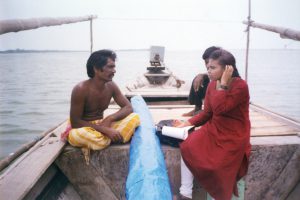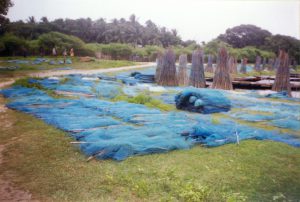Rights, Resources, Markets, Livelihoods: Fishing in Chilika Lake
In the third instalment of CORD’s blog series, Ranjita Mohanty follows Fiona Anciano in reflecting on the subsistence of fishing communities, this time in India. Here, once again, we discover fishers who must navigate tensions wrought by poorly designed and enforced state regulations, uncompromising market forces, and a history of regressive identity politics. Mohanty’s account fits squarely within debates around recognition, redistribution, and the state’s role in development.
By Ranjita Mohanty
Ranjita interviewing a fisherman in Chilika
This is a rejoinder to Fiona’s blog titled “Why State governance of fishing rights in South Africa combined with black market demand has turned fisherfolk into poachers.” Reading Fiona’s description of the nature of state policy and state intervention in fisheries as also the plight of poor fishing communities in Hout Bay, I found striking resonance to what I had encountered in Chilika in the early 2000s. While the state recognized the rights of traditional fishing communities in Chilika and regulated the marketing for fishing communities to get a fair price, it confined them to subsistence. The poor fishing communities could not gain access to the growing commercial market because the state mandated cooperative structures through which they operated could not change to accommodate them in a changing global market. As prawn became an export commodity and commercial prawn cultivation began in the lake mostly by resourceful people from outside the lake, the cooperatives and poor fishers came under increasing pressure to engage in activities that contravened the boundaries set by the state. While the state bounded the poor fishing communities with prescribed rules and regulation for subsistence, it facilitated market access and profit to resourceful people and agencies to further their commercial interests.
The quiet scenic beauty of Chilika makes it a popular tourist destination. Located in the Eastern part of India, Chilika is a large brackish water lagoon and home to large varieties of fish and plants that thrive in brackish water. The villages in and around the lake are inhabited by a heterogeneous population comprised of both fishing and non-fishing communities belonging to different castes. Fishing and agriculture are the two primary sources of livelihood for these people. The lake is also a bird sanctuary where the bird watchers gather in large numbers to watch nearly 132 species from Siberia who migrate to Chilika in winter. The lake has attracted poets and writers to describe the beauty of the lake. Not many know the underbelly of Chilika where the discontents of the poor fishing communities simmer and occasionally explode. One major explosion occurred in early 1990’s when the government allowed a multinational corporate house (TATA) an advance possession of 400 hectares of land in Chilika for a joint semi- intensive prawn culture project called the Integrated Shrimp Farm Project (ISFP). The discontents that were simmering among fishing communities found expression in a mass movement. Doing fieldwork in Chilika almost a decade later, I didn’t find the situation had changed for the poor fishing communities except that the corporate agency was gone, but the encroachment on the lake by resourceful businessmen from outside the lake had continued.
Fishermen and their catch
The fishers in Chilika belong to lower castes and most of them are either landless or possess small landholdings. They, therefore, are completely dependent on fishing. The non-fishers belong to upper castes and are engaged in agriculture. A large number of them, however, have taken to fishing to supplement their income because the productivity of the land is low due to salinity, erratic monsoon and lack of irrigation facilities. Ever since white prawn and tiger prawn became lucrative export commodities, rich businessmen from outside the lake began shrimp farming in Chilika thus displacing the fishing communities from their resource base.
The state regulations related to fishing rights of the fishing communities were marred by lack of clear cut demarcation of fishing sources, types of net to be used, and barricades to be set up to catch prawn. The ambiguities persisted with a government regulation in 1991 that divided the fisheries in Chilika into two categories- capture and culture. Capture fishing is done through nets and traps; culture fishing requires construction of embankments and creation of ponds in which shrimp can be cultivated. The fishing communities were given both capture and culture rights. The culture sources, however, were opened to non-fishers and those villages which were not members of primary societies. The government regulation did not lay down any guidelines for the operation of capture and culture fisheries. The fishing communities feared that their traditional rights were being curtailed by leasing out culture sources to non-fishers.
The traditional fishing communities trace their fishing rights to the British period. During the time Chilika fishery sources were controlled by kings to whom the fishers paid royalty to obtain the permit for fishing. In order to protect the interest of fishers and eliminate non- fishers/ traders encroaching on the lake, a co-operative society- Balugaon Fishermen Co-operative Store- was established in 1926. It brought 24 fisheries under it. After the abolition of the estates in 1953, fishery sources came within the purview of the government. The fisheries were leased out through open auction to fishing communities. The non-fishers were allowed to take a limited number of fisheries. A Central Cooperative Marketing Society was established to act as an apex body that would take lease from the government and sublease them to the primary fishermen co-operatives. A dual co-operative structure was thus established to protect and regulate the fishing rights of people. It is imperative to note that the fishing rights were confined to fishing communities. The cooperatives allowed the non-fishing communities limited fishery sources.
Despite the reiteration by the government that the policies were meant to safeguard the traditional rights of the fishing communities, the policies did not yield the desired effect for various reasons- they were ill defined, there was lack of equitable distribution of fisheries, and there was widespread illegal subleasing of fisheries without any mechanism to prevent it. The Central Society itself made erratic distribution and illegal subletting. Many primary societies bypassed the Central Society and marketed directly through commissioned agents. The very purpose of a dual co-operative structure designed to protect the interest of the fishing communities was thus vitiated.
Fishing equipment: nets and bamboos
Initially, the culturing of prawn began in the peripheral landmass of Chilika. Later the lake, deeper Chilika, was enclosed with bamboo poles and nets required for prawn culture. The culturing of prawn on a big scale resulted in widespread conversion of traditional fisheries into prawn culture ponds or net enclosed gheries (barricaded space). Culture fisheries require heavy capital investment and ensure profit. Many primary societies contravened the state regulations and sublet fisheries to resourceful persons from outside the lake.
Traditional fishermen unions were revived to protest against the TATA prawn project. The issues of livelihoods of poor fishing communities were blended with the ecological threats from the project. While the movement was vociferously articulating the interest of the fishing communities, a court judgement relating to the rights of the fishing communities in Chilika clearly put a stop on intensive or semi-intensive prawn cultivation. The judgement was in response to a case filed by a few primary societies against the 1991 state policy and the subsequent encroachment on the rights of the fishing communities.
The Chilika case reveals the paradoxes and ambiguities that characterize state construction of rights for the poor. The state action destroys the traditional livelihood sources by diverting them for commercial use even as the state makes policies protecting the traditional fishing rights. While the state subverts the rights of the fishing communities, it also passes judicial pronouncements to safeguard the rights. The judicial intervention, however, could neither make the state formulate policies to facilitate the access of poor fishers to commercial market nor could it stop resourceful people from encroaching upon the fishery resources of the poor.
We can clearly discern the two faces of the state in Chilika and Hout Bay- one for the poor and one for the market. The schism between people-centric governance and market-centric governance was quite palpable in Chilika as much it is in Hout Bay. In both the cases, we find that the state constructs rights but at the same time it creates conditions for the contravention of those rights. Both the cases point out the limitations of the state, even when it is a democratic state, to protect the rights of the poor against the market forces.



